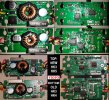Considering that the Sony Starvis 2 sensors operate internal logic at 1.1V and Novatek processors use 1.0V, using a linear regulator to convert the ">5.5v" would increase power consumption by around 5x. If we could have parking mode last 5x longer, just by swapping to a switching regulator...
Last few various cameras i pulled apart had a 3v3 and 1v8 linear regs for various sub systems, dont recall exact models nor sensors.
Quite fair the Starvis uses 1v1 and the cpu otherwise, but a few of the internals will also be using the full 5v or possibly 3v3, the 129 pro duo seems to use input voltage this for it's display backlight based on reaction to changing input voltage.
I don't know what current the sensor or SoC use specifically, but sure would be much more efficent and very good practice to use efficent and good quality switching regs for these subsystems.
The problem i have is that even when it would be obvious to do so i rarely see best practice out in the wild of cheap consumer electronics.
In an ideal world i would 100% love to assume that ever product, big or small is crafted to the highest standard with the best practices available.
Here on earth for all practical discussion I'll fall back to my practical experience.
And this isn't a knock to Viofo. Just about every company that brings electronics to market are guilty of
Muntzing their products to varying degrees to simplify and/or reduce cost.
I do it to a limited degree myself to simply designs, usually just backing off on having excess bypass capacitors is only about as far as i go.
Let's be clear, I *WANT* to assume that Viofo use switching regs.
But again as i say I'm just operating with the practical experience i have, in a vacuum without an answer.
I don't own a single Viofo product, never have... I just ended up here as a result of having 2 back to back wildly and
verifiably faulty HK3's as part of a chain of issues with my fathers cam install.
And going back to see myself being attacked for showing these failures and finding more in the wild pisses me off when all i did is document what i found, the good and the bad.
So pardon me if i've coming across a bit sour.
As for the assumptions, many things are assumed in day to day life, the sun will some up tomorrow etc... they are ultimately inconsequential however to the issue at hand.
If you have anything to add aside from attacking these assumptions, be my guest.
If you have a unit you can pull apart then go for it, i'm always open to new information and can certainly change my views.
The real issue is that many more of these HK3's are out in the wild possibly on the verge of vailure, and it's possible i might have found another.
So for now lets drop the cam issue, this thread isn't even about that... every viofo cam i've run from a good clean 5v source has functioned perfectly.
I only concern myself with the power architecture inside a little as the power they draw is pushing the limits of the HK3/HK4.
As i've said i've not seen a HK5.




